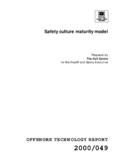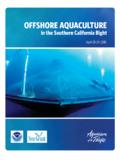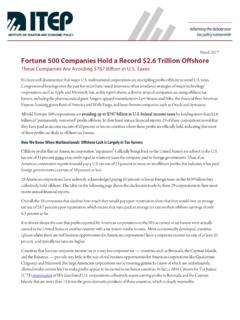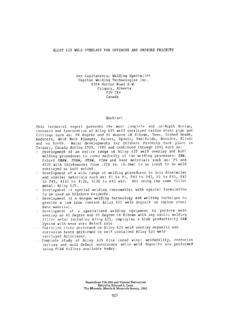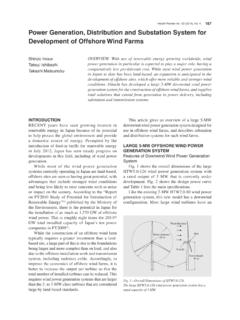Transcription of OFFSHORE TECHNOLOGY REPORT 2001/063
1 HSEH ealth & SafetyExecutiveMarine risk assessment Prepared by Det Norske Veritasfor the Health and Safety ExecutiveOFFSHORE TECHNOLOGY REPORT2001/063 HSEH ealth & SafetyExecutiveMarine risk assessment Det Norske VeritasLondon Technical ConsultancyPalace House3 Cathedral StreetLondon SE1 9 DEUnited KingdomHSE BOOKSii Crown copyright 2002 Applications for reproduction should be made in writing to:Copyright Unit, Her Majesty s Stationery Office,St Clements House, 2-16 Colegate, Norwich NR3 1 BQFirst published 2002 ISBN 0 7176 2231 2 All rights reserved. No part of this publication may bereproduced, stored in a retrieval system, or transmittedin any form or by any means (electronic, mechanical,photocopying, recording or otherwise)
2 Without the priorwritten permission of the copyright REPORT is made available by the Health and SafetyExecutive as part of a series of reports of work which hasbeen supported by funds provided by the the Executive, nor the contractors concernedassume any liability for the reports nor do theynecessarily reflect the views or policy of the Summary Risk assessment provides a structured basis for OFFSHORE operators to identify hazards and to ensure risks have been to reduced to appropriate levels in a cost-effective manner. The regulations applying to OFFSHORE operations in the UK require operators to undertake risk assessment in order to identify appropriate measures to protect people against accidents, so far as is reasonably practicable.
3 However, few marine operations have been reviewed using risk assessment methods. It may well be that the use of Quantitative Risk Assessment (QRA) for Temporary Refuges has given the impression that risk assessment is synonymous with QRA. The safety of OFFSHORE installations against marine hazards has traditionally relied on International Maritime Organization (IMO) legislation and classification society rules. These rules have been developed by expert judgement, responding to previous accident experience, and in general prescribe specific design solutions. They are only rarely based on risk assessment, and do not by themselves satisfy the requirement to perform a risk assessment.
4 It is the purpose of this Guidance to encourage greater use of risk assessment methods for marine operations especially those methods towards the simpler end of risk assessment: the qualitative and semi-quantitative techniques. It explains risk assessment TECHNOLOGY as it might apply to marine operations, emphasising techniques appropriate to marine hazards. While QRA has a role in some marine applications, this Guidance demonstrates how the wider range of techniques can help operators perform a suitable and sufficient risk assessment, and demonstrate that risks are As Low As Reasonably Practicable (ALARP).
5 Section 1 of the guide outlines the regulatory system for safety of marine operations, and discusses the role of risk assessment in meeting this framework. In particular, it reviews some recent HSE and industry views on risk assessment; and considers the overlap with Classification Society Rules and newer risk-based rules. Section 2 gives details on the various approaches to risk assessment, including qualitative, semi-quantitative and quantitative techniques. It considers their strengths and weaknesses for marine applications, and gives references to source material with further information.
6 Section 3 describes the way risk assessment results can be used to provide input to a decision-making process. This includes the use of risk criteria and cost-benefit analysis within an ALARP framework. Appendix I gives a glossary of terms and abbreviations used in the guide. Appendix II gives some worked examples of how to choose an approach to marine risk assessment that will be suitable and sufficient. This guide primarily covers mobile OFFSHORE installations, which include semi-submersibles, jack-ups and heavy lift vessels. It also covers floating production systems (FPS), which are often based on semi-submersible or ship hulls.
7 Some of the hazards and hence the guidance may also be relevant for fixed steel and concrete installations and tension leg platforms. The guide does not cover shuttle tankers, supply vessels, stand-by vessels and other OFFSHORE industry vessels not required to submit a safety case. iv v Contents 1. Background ..1 Application ..2 Regulatory Context ..3 Marine Regulations ..5 Risk Management and Decision-Making ..9 Conclusions ..12 2. RISK ASSESSMENT METHODOLOGIES ..13 Choice of Approach ..13 Hazard Qualitative Methods ..28 Semi-Quantitative Quantitative Methods.
8 37 Human 3. DECISION Overall The ALARP Principle ..53 Risk Criteria ..55 Cost-Benefit Analysis ..60 Demonstration of Uncertainty in Decision-Making ..67 Benefits Beyond Decision-Making ..68 Suitable and Sufficient Risk Assessment ..68 4. Appendices APPENDIX I GLOSSARY APPENDIX II WORKED EXAMPLES vi 1 1. INTRODUCTION Background The use of risk assessment techniques in major hazard industries has grown significantly in recent years. This is particularly true in the OFFSHORE industry in the UK where many aspects are subject to full risk assessment, notably the Temporary Refuge assessment which is mandated to be analysed using Quantitative Risk Assessment (QRA).
9 Other aspects of OFFSHORE facilities, such as related marine operations have tended to rely on meeting regulatory requirements, industry codes of practice, or Classification Society Rules. Risk assessment is now a proven TECHNOLOGY for operators to address larger hazards in a structured manner, and to ensure risks have been to reduced to appropriate levels cost effectively. This applies as well to marine operations as to topsides safety. However, the OFFSHORE Safety Division (OSD) has noted few marine operations have been reviewed using risk assessment methods.
10 It may well be that the use of QRA for Temporary Refuges have confused people in the maritime industry into thinking that risk assessment was synonymous with QRA. At the QRA: Alchemy to Acceptability Conference in London in 1993, a set of quotes was presented reflecting the industry view of risk assessment and how this perception had changed over a 15 year period. Whilst this was specifically the oil industry view, it is likely that other industries introducing these techniques will also pass through these stages, albeit in less time if they learn from other industry s lessons.










